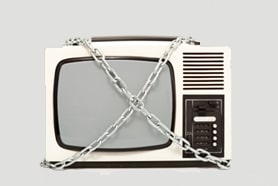Top 6 Threats For Television Broadcasters
Home » Top 6 Threats For Television Broadcasters
- January 25, 2017

Streaming services have been threatening to take a bite out of linear TV broadcast viewership for quite some time. However, it is only recently that television broadcasters have begun to feel the threat. According to a study conducted by Michael Nathanson of MoffettNathanson, Netflix’s US subscribers were up to six percent in 2015 from 4.4 percent in 2014.
As the future of television broadcast is threatened, we list six top challenges faced by broadcasters due to the rise of digital and streaming media.
1. The Rise of Alternative Media Channels
With the digital revolution gaining momentum, viewers now want to cherry pick their favorite channels, which is why streaming services over the internet are on an all-time rise. There has been a shift in the viewing habits, posing a threat to the decade-old model built around satellite and cable TV offering ‘bundled’ channels to consumers at a fixed price that offered little choice to viewers.
Now, viewers can access video channels like Amazon video, Netflix, Hulu; choose a subscription of individual channels like Showtime or HBO, or watch programs streamed on YouTube and other free online channels.
With the rise of alternative media channels, television broadcasters are facing a major threat in the form of what is popularly known as ‘cord cutting.’ According to a 2016 research by Leichtman Research Group , the cord-cutting trend began in 2013 when cable providers lost 100,000 subscribers. The figures went up to 150,000 in 2014 and 385,000 in 2015, thanks to on-demand platforms like Netflix that charge a fraction of what television broadcasters charge to stream programs.
2. Content and Network Security
Missed your favorite prime-time show? Login online to watch it anytime you want. Viewers now have the option to enjoy their favorite programs on any smart devices anytime they want. With the emergence of TV Everywhere, pay-tv operators are now offering TV Everywhere to provide value add and retain their subscribers.
However, TV Everywhere has its risks for broadcasters. As broadcasters use new media platforms to reach their millennial viewers, they are prone to security threats like hacking, malware, and cyber-attacks. Often, viewers also compromise their security by sharing devices, accounts and personal information to access the content, thereby giving easy access to hackers. Moreover, with the easy availability of network infrastructures, programs are being redistributed in real-time over the Internet illegally, resulting in loss of estimated billions of euros across the TV industry worldwide.
To address this challenge, broadcasters need proper infrastructure, security policies, and firewall protection to ensure hackers do not have access to the content. Moreover, old content needs to be digitized, archived and stored with proper tagging to ensure long term usage.
3. Changing Viewer Behavior and Preferences
As new digital platforms evolve, there is a distinct shift in consumer behavior and preferences. Users no longer consume what is being offered to them, but choose from a host of options available to them anywhere, anytime across multiple channels.
Traditional content providers are fighting hard to ride the digital wave and secure their place in the value chain by understanding customers’ interests and upselling the right products to cater to their preferences. TV broadcasters are facing a significant threat due to changing preference of the viewers and need to create and recycle content to cater to the changing behavior.
4. Content Protection and Piracy
In a world where news and videos go viral in minutes, content can travel across geographies fast. Thanks to the Internet, viewers now have the power to generate the content they like, share it with the world and gain instant popularity.
However, reliability and accuracy of such content remain a concern. Broadcasters might get into legal hassles like copyright issues or defamation if the authenticity of user-generated content is not verified. Similarly, illegal commercial distribution of content originally owned and produced by broadcasters may lead to revenue loss.
5. Mismanaged Content
Mismanaged content is a major challenge that broadcasters face today. While there is a lot of new content generated both by the user and broadcasters every minute, it might not be organized for future usage. Much of the content is not tagged correctly and do not have metadata, which makes it impossible for broadcasters to compartmentalize for reuse, often leading to content duplication.
With a huge amount of content already being created alongside legacy content, broadcast organizations need to organize and tag content to ensure easy search, access and distribution of existing content.
6. Lack of Quality Content
With modern technology and changing of viewers’ preference, there is a huge demand for content. However, to meet the growing need, quality of the content often takes a backseat.
To ensure quality, broadcasters need to utilize the content that is already in use. Recycling legacy content and going regional to cater to different geographies are some of the measures that content creators need to take apart from creating new content.
The television industry is gearing up to meet the digitization challenge. As viewers are spoiled for choice, the television ecology is becoming more democratic. Broadcasters are propagating online programs to catch the viewers’ attention and become accessible to new audience.

